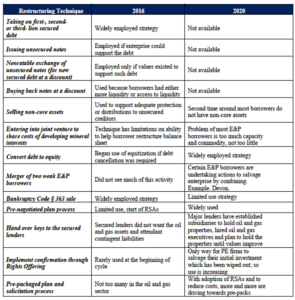Between 2010 through 2014, many United States oil and gas upstream companies borrowed money and bid against each other to buy up prospective shale reserves around the country suitable for fracking. When prices were high, these companies made money and transformed the United States from a net oil importer to an exporter. But Saudi Arabia did not like losing market share and fought back by opening its spigots, creating excess supply and causing oil prices to plummet from above $100 a barrel in the summer of 2014 to half that price the following year.
Dozens of heavily indebted American companies were forced to file for bankruptcy protection between 2015-2018. The industry came up with significant cost-cutting innovations and production continued at $55 a barrel. Many concerns sold their assets, but others reorganized using various assumptions about oil and gas prices for the foreseeable future. Even before the onset of the pandemic, several of the companies that had reorganized needed to file bankruptcy again. Vanguard Oil & Gas, Ultra Petroleum and Halcon Resources as just three examples.
With the pandemic and further plunging of oil prices, a new surge of oil and gas chapter 11 cases is taking place. Unless prices improve significantly, about 150 more North American exploration and production companies will need to seek Chapter 11 through 2022. Some of those cases will have been cases that earlier sought and obtained relief in a previous chapter 11 bankruptcy case.
Exploration and production (“E&P”) companies rely on a combination of reserve-based revolving loan (“RBL”) financing facilities and unsecured bonds to operate their business and fund their drilling programs. RBL facilities typically provide for semiannual redeterminations of their borrowing base and a yearly discretionary redeterminations at the election of the borrower or lenders. Lower reserve values, ongoing roll-off of favorable hedges, and increasing regulatory pressure on U.S. banks engaged in oil and gas lending is causing RBL lenders to reduce their exposure to this sector. The fall 2015 redetermination resulted in an average 9% reduction in overall borrowing base for E&P companies. The Wall Street Journal, 12/3/2015.
What the companies, bankruptcy lawyers, investment bankers and financial advisors did not know in 2016 was how good the oil and gas industry had it compared to 2020. As a result of Covid 19, the glut in the availability in the amount of oil and gas due to among other things, the success of the U.S. shale industry, increased production from Saudi Arabia and Russia and the overall lowering of demand for oil and gas due to the pandemic, the oil and gas upstream industry faces one of the most challenging periods now and for some time. Experts are not predicting any price improvement for some time. At current price, most American shale producers are not able to avoid insolvency.
As the diagram below also shows, the techniques available to restructure these concerns may also be drastically limited in 2020 as opposed to what was available in 2016.

The content of this blog post is for informational purposes only and does not constitute legal advice. It provides a summary, and the referenced materials should be reviewed for full details. The information may not reflect current legal developments. The date of the publication of the post is applied at the discretion of the editor and no reliance should be made on the date of publication. Please reach out to Parkins & Rubio LLP or your attorney for guidance.
Topics Discussed: Bankruptcy Protection, Oil & Gas
